A trip along Israel’s Route 60 – a road of heartbreak, hope and division
The road from Nazareth to Beersheba cuts between Israeli settlements and Palestinian villages, and reveals just how distant a two-state solution has become, writes Steve Hendrix
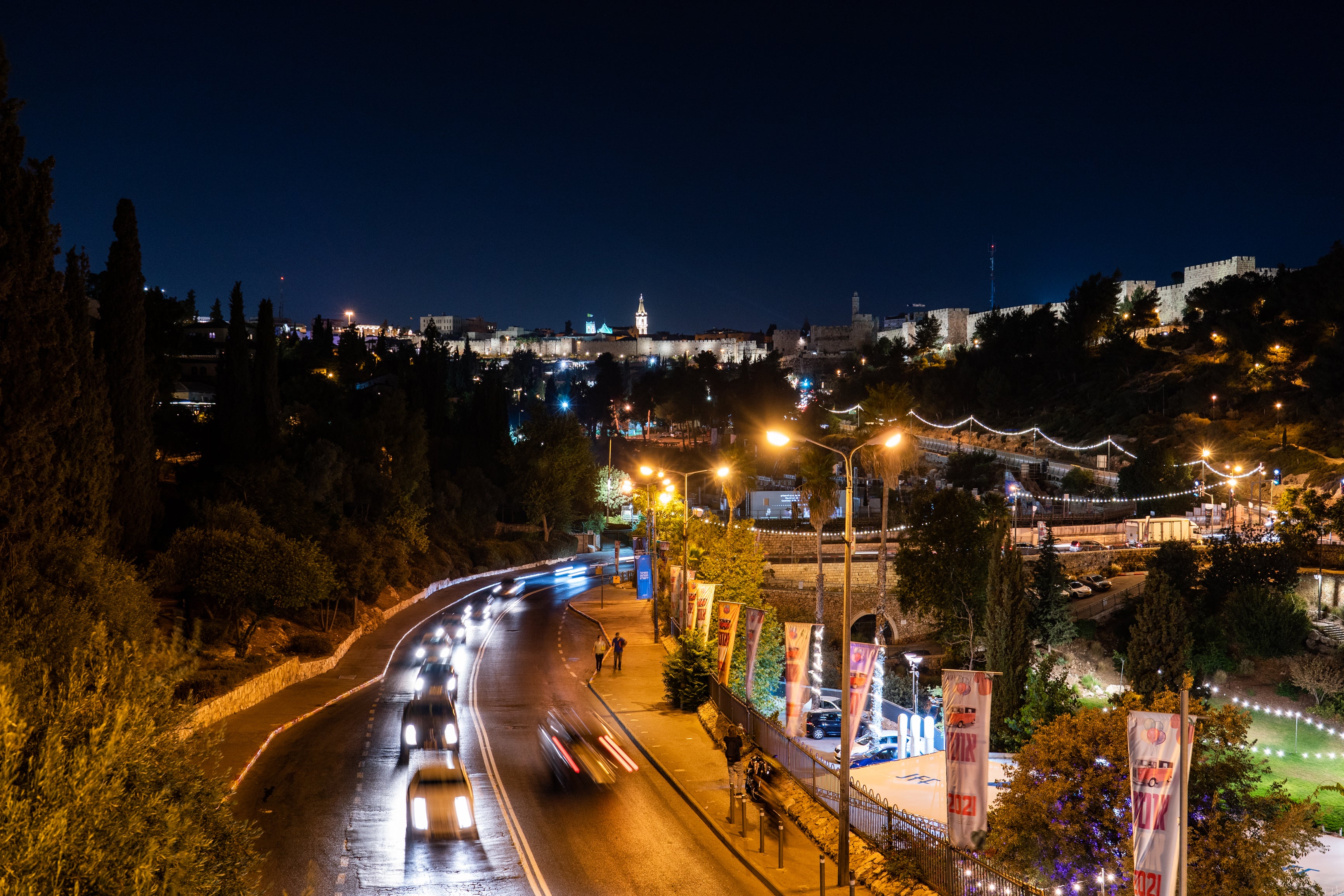
Your support helps us to tell the story
From reproductive rights to climate change to Big Tech, The Independent is on the ground when the story is developing. Whether it's investigating the financials of Elon Musk's pro-Trump PAC or producing our latest documentary, 'The A Word', which shines a light on the American women fighting for reproductive rights, we know how important it is to parse out the facts from the messaging.
At such a critical moment in US history, we need reporters on the ground. Your donation allows us to keep sending journalists to speak to both sides of the story.
The Independent is trusted by Americans across the entire political spectrum. And unlike many other quality news outlets, we choose not to lock Americans out of our reporting and analysis with paywalls. We believe quality journalism should be available to everyone, paid for by those who can afford it.
Your support makes all the difference.Israel’s Route 60 begins at a traffic light in the city of Nazareth and heads due south along a course that can be measured in both miles and centuries. Its path largely follows the ancient “Road of the Patriarchs”, running through Nablus and Hebron just as it did in biblical times. The roadway traverses an antique landscape from the Galilean hills in the north to the Negev Desert in the south, winding among terraced hillsides – slanted pancake stacks of white limestone rising from olive groves and tobacco fields – and skirting the great stone walls of Jerusalem’s Old City.
These days, the two-lane highway cuts through a topography of conflict, curving between Israeli settlements and Palestinian villages. While it begins and ends inside Israel, most of its 146 miles trace the spine of the occupied West Bank. If Palestinians ever achieve an independent state, Route 60 will be its national road.
But now, with the goal of Palestinian statehood once again at the centre of American diplomacy as part of a “two-state” solution to the Israeli-Palestinian conflict, a road trip along Route 60 reveals just how distant that prospect has become.
After a four-year tilt toward Israel’s right wing by president Donald Trump, president Joe Biden has doubled down on the vision that has otherwise long been championed by US administrations and most western governments: the creation of a sovereign Palestinian state existing in peace alongside a secure Israel.
In the moments after a cease-fire ended hostilities in May between Israel and the Hamas militant group, Biden immediately urged new efforts toward this two-state solution. Secretary of state Antony Blinken has, in recent months, repeatedly put this at the centre of US diplomacy in the region. Biden’s reboot, however, comes at a time when conditions for Palestinian statehood have never seemed less ripe or the status quo of occupation more entrenched.
The troubled state of statehood is immediately visible out the windows of vehicles travelling Route 60. There are the Israeli settlements that have not only grown larger in recent years, now home to a half-million Jews in the West Bank, but also are reaching deeper into occupied territory, hollowing out any future Palestine. Israeli businesses are proliferating, attracting Palestinian labour and spending, while the local economy that would sustain a state founders.
In Jerusalem, zealotry is on the rise, crowding out hopes for compromise over the city that both peoples claim as their capital, and the mounting corruption, incompetence and brutality of the Palestinian leadership is sapping its people's faith in its ability to govern, much less achieve, a future state.
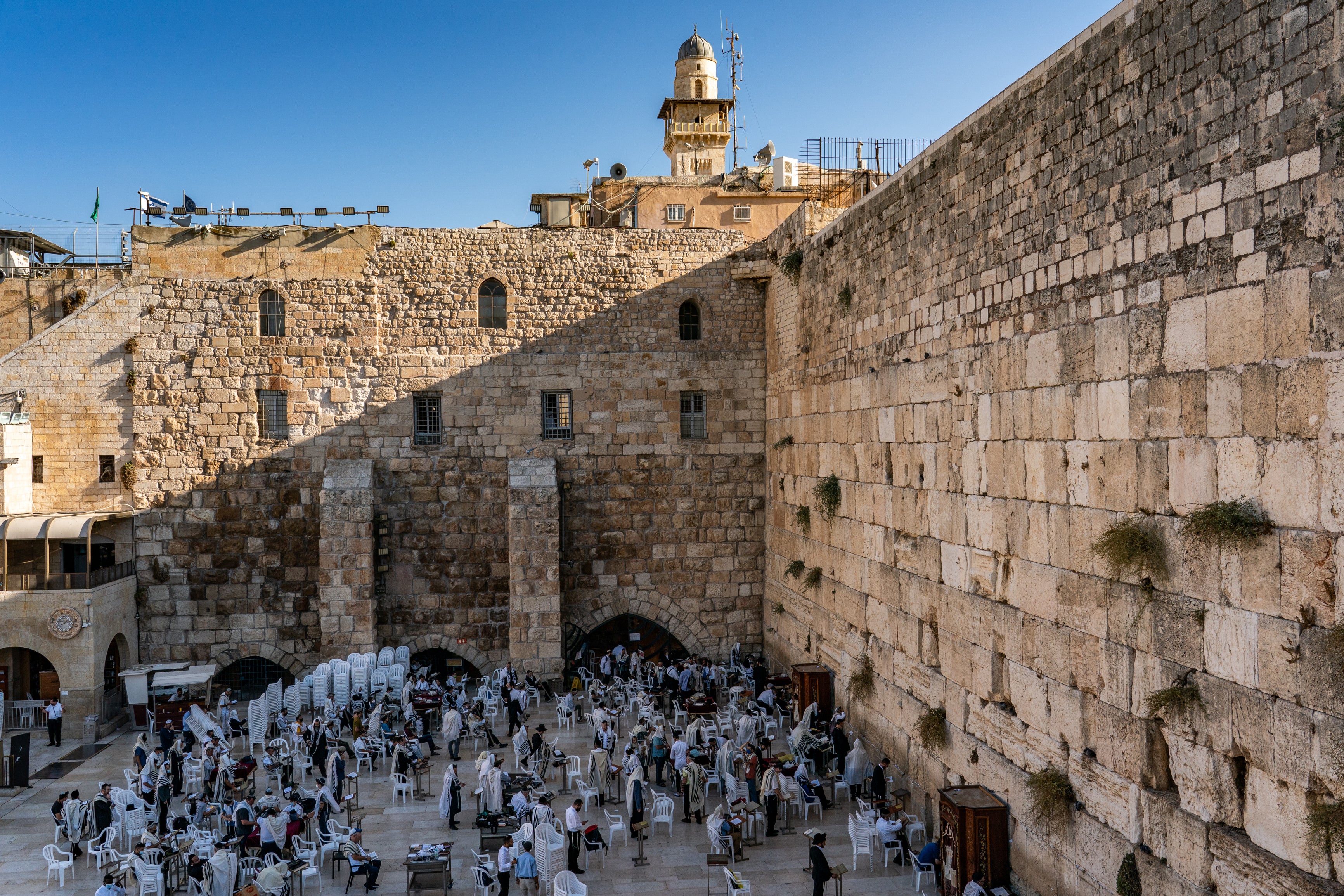
Fifteen miles south of Nazareth, there is no doubt when Route 60 crosses from Israel into the West Bank. Past the last Israeli gas station and a handwritten Hebrew sign advising Jewish farmers about an evening prayer service, the highway funnels through an Israeli military checkpoint. Beyond, the signs on garages and shops are all in Arabic, men in plastic chairs smoke hookah pipes, and women in headscarves bag up fruit in the markets.
Separating these two worlds is the Green Line, the internationally recognised boundary between Israel and the land it captured in the 1967 war. Many Palestinians envision the line as the border of any state. Many Israelis pretend it doesn’t even exist.
Mile 18: Jenin
Trapped between war and peace
The banner hanging over the doorway of the cinder-block building in central Jenin bears the photographs of four men, all young, all smiling, all dead. They were killed a day earlier by Israeli border police conducting an armed raid.
Within hours of their deaths, the pictures had been gathered, the banners professionally printed and then distributed around town. The mechanics of mourning are well practiced in the West Bank city, a hotbed of Palestinian nationalists located less than a four-mile drive south of the Green Line along Route 60.
On the August night that Raed was shot, Israeli forces had entered the city to arrest suspected militants and opened fire when they were confronted by Palestinian gunmen and rioters
Palestinian men file into the building. They have come to pay their respects to the family of the dead, as they have done often before. The wide room is crowded with men on plastic chairs, smoking and sipping coffee. Hundreds of framed photographs of those who were killed previously are mounted across the walls.
The mourning tent is an Islamic custom. In Jenin, the “tent” feels as permanent as a Rotary Hall. Here, what negotiators a generation ago had envisioned as an interim phase between conflict and a final resolution of the Israeli-Palestinian dispute also feels permanent. It is neither war, nor peace, but an inexorable bloodletting that has become a choreographed routine on both sides.
As the vision of a different future fades, this is all that people like Ziad Abu Saif can see. Abu Saif sits near the front door, bent low, his arms resting on his thighs, but straightening to shake hands whenever a newcomer stops to greet him. His 21-year-old son Raed is one of the faces on the banner.
“Allah yerhamo,” they say. “God have mercy on him.” One man leans down: “You should be happy you are the father of a martyr. He will be your companion to heaven.”
Abu Saif nods without speaking.
On the August night that Raed was shot, Israeli forces had entered the city to arrest suspected militants and opened fire when they were confronted by Palestinian gunmen and rioters, an Israeli military official said. The three men killed along with Raed were terrorists, the official alleged, but he did not say that Raed was.

Abu Saif says his son had nothing to do with militant cells, that he had never been in trouble, that he was a waiter at Al Bustan Restaurant on his way home from work when he joined a crowd to see what the noise was all about. “My son was just standing and watching with everyone else, and they shot him in the lung,” Abu Saif says, shaking his head. He was one of many Palestinians who said Israeli snipers fired on the crowd from rooftops.
“When I was his age, I thought I would someday live in a free country,” he says as the well-wisher moves off to join the murmuring crowd. “Then I thought, my son will live to see it.”
“I am 60 years old, and I have seen this my whole life,” he continues. “Now they have killed my own son. Even now, I know nothing will change.”
A few blocks away, another banner bearing the images of Raed and the other dead men hangs outside Jenin’s city market. Below, shoppers press along the crowded street, holding their children’s hands, looking at phones. They take little notice of the new batch of faces portrayed overhead.
Mile 56: Evyatar
A relentless expansion of settlements
For people being kicked out of their houses, the settlers are in a fine mood. Neighbours chat as they load hampers into hatchbacks. Children play. Men with knit yarmulkes and automatic rifles burst into song: “Am Yisrael chai – the people of Israel live!”
It’s eviction day in Evyatar, a hilltop outpost a few hundred yards off Route 60 in the arid countryside about an hour’s drive south of Jenin. But the dozens of settlers in Evyatar, religious Zionists who claim all they can see from these heights as part of the biblical Jewish homeland, know they will soon return.
“Politicians don’t control this world. God does,” says Eli Shapira as he pauses from loading his white Nissan.
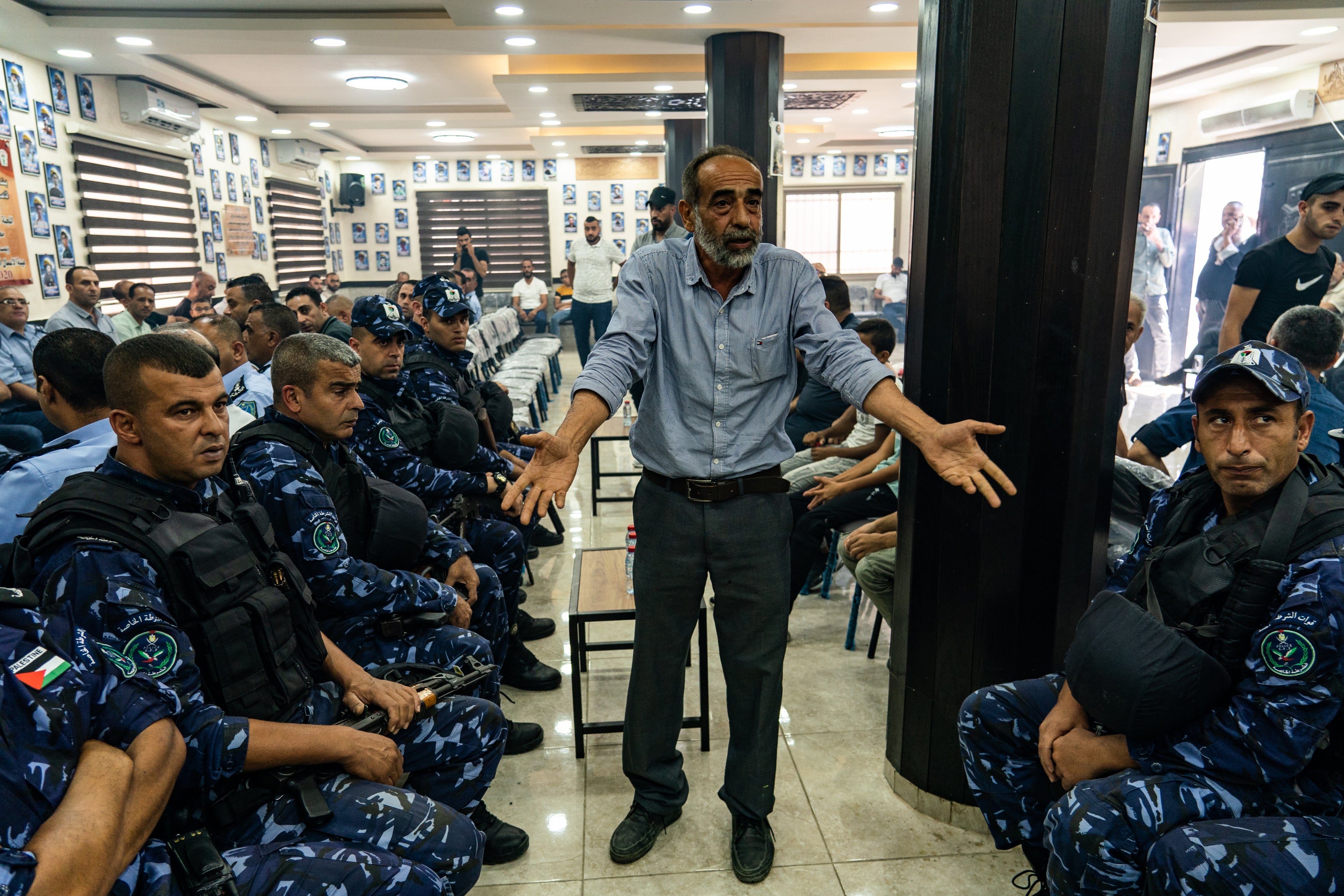
“We will come back on a mission that this place will become a town,” promises Ayelet Schlissel, shading her eyes from the morning glare as men rush to mount a towering Israeli flagpole behind her. “And in 15 years, maybe we will move on to another mission to build another town.”
Almost overnight, the founders of Evyatar had extended Israel's network of settlements even deeper into the West Bank, planting the outpost among a cluster of Palestinian villages. It is the newest of more than 100 settlements reaching ever farther into occupied territory, each adding another Palestinian no-go zone to the heart of a would-be Palestine.
Amid Palestinian olive groves south of the city of Nablus, settlers built this community – houses for about 50 families, paved streets, sewers and a synagogue – in a matter of days in May with help from hundreds of volunteers bused in by a right-wing group that aims to derail Palestinian statehood.
Because Evyatar was erected without formal Israeli government approval, the Israeli army said the settlers would have to leave. Previous attempts to evict unauthorised outposts have led to clashes between settlers and soldiers. But these settlers – younger and more politically plugged in than previous generations of religious Zionists – have instead brokered a deal with the government: they would vacate, but for only as long as it took to survey the land and gain official approval.
Israeli settlements have expanded relentlessly in recent decades, but these new outposts, like Evyatar, pose a particular challenge for the creation of a Palestinian state. Traditionally, most Jewish settlers have lived in communities close to the Green Line, and mapmakers drawing the boundaries of a future Palestine often envision these settlements ultimately being incorporated into Israel, perhaps as part of a land swap with Palestinians.
But settlements like Evyatar, deep inside the West Bank, strike at the very integrity and coherence of any independent state. Over the past 10 years, more than 53,000 settlers have moved to homes at least three miles inside the West Bank, a 47 per cent increase in this population, according to Peace Now, an Israeli advocacy group. More than 31,000 of them have moved to settlements at least six miles from the Green Line.
The shouts of Palestinian protesters float up from below. Smoke from their burning tires scents the air
Ali Akal, a 32-year-old Palestinian, can see Israel’s advancing edge from the surrounding cluster of villages where his family has lived for generations. “It is already cutting us off from the other villages,” he says, while working in his uncle's butcher shop on Route 60. As he slices meat from a lamb carcass hanging on a hook, Akal describes how the growing West Bank settler population – now exceeding a half-million – constricts his freedom. Each new settlement drags a contrail of roads and water lines and restrictions across routes that used to be open to Palestinians.
Pop-up army checkpoints can add an hour to a 10-minute drive. Just down the highway from where he threads cubes of lamb on to a skewer, Israeli road crews are building a Route 60 bypass to better accommodate settler traffic. The project, he says, conflicted with local plans to extend sewerage to 2,000 Arab homes, which then had to be abandoned.
“It’s not only hard to imagine making a continuous state here; it’s even hard to make a continuous city,” Akal says, wiping his hands. “They are taking our sovereignty bit by bit.”
Back atop the hill, Israeli soldiers stand guard around the perimeter as the Jewish families pack up. The shouts of Palestinian protesters float up from below. Smoke from their burning tires scents the air.
Suddenly, at the highest point of the hilltop, a crane rumbles. Slowly, it lifts a huge Star of David crafted of welded steel into the air. Men scramble to cement it firmly into the limestone. From Akal’s village, it can’t be missed.
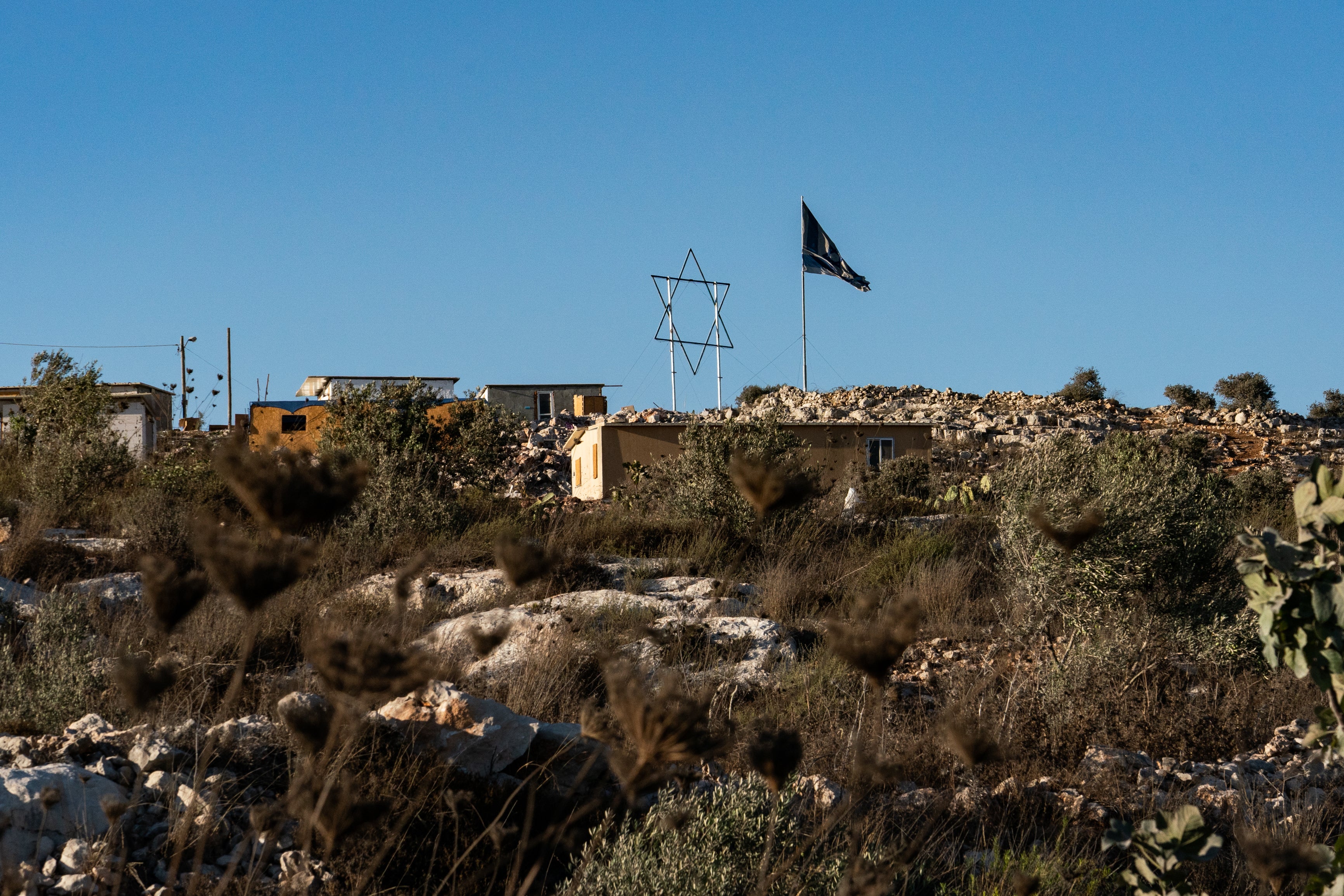
Mile 78: Sha’ar Binyamin
An economy crippled
It takes only minutes for Jamil Hazalin to walk to his job just over the ridge. The delay each day comes at the gate to the Sha’ar Binyamin industrial park, an Israeli settlement located about a half-hour drive south of Evyatar along Route 60. Israelis pass freely; he is told to wait, and his ID is checked by the same guards who checked it yesterday and will check it tomorrow.
“They know me, but still they put me through this, while the Jews just pass through,” says Hazalin, 40, wiry and bronzed from a lifetime of outdoor work.
The daily humiliation is a price he pays for plugging into a West Bank economy that has grown critically dependent on Israeli jobs and goods in recent years. Israeli restrictions on Palestinian development and economic activity in the West Bank, coupled with Israeli control of key resources like water, have stunted the growth of a local Palestinian economy that could underpin a viable state.
Hazalin is one of 40,000 West Bank Palestinians who turn to Israeli settlements for a paycheck. Another 140,000 cross the Green Line into Israel every day for work. That’s about one-fifth of all Palestinian workers in the West Bank.
In the morning traffic crawling along Route 60, cars with Palestinian license plates carry workers like Hazalin to settler factories and construction sites. Other vehicles ferry farmers who until recently planted their own crops to jobs in settler fields and greenhouses, which in turn depend on land and water diverted from Palestinian use. Agriculture and fishing have dwindled from 12 per cent to 3 per cent of Palestinian gross domestic product since the first Oslo accord was signed in 1993, according to the United Nations. Manufacturing has been nearly halved, from 20 per cent to 11 per cent.
Many of the passing panel vans bring fruit, milk and yogurt from Israel to shops in Jewish settlements and Palestinian villages. Palestinian shoppers spend their Israeli wages on Israeli goods their own market is not producing.
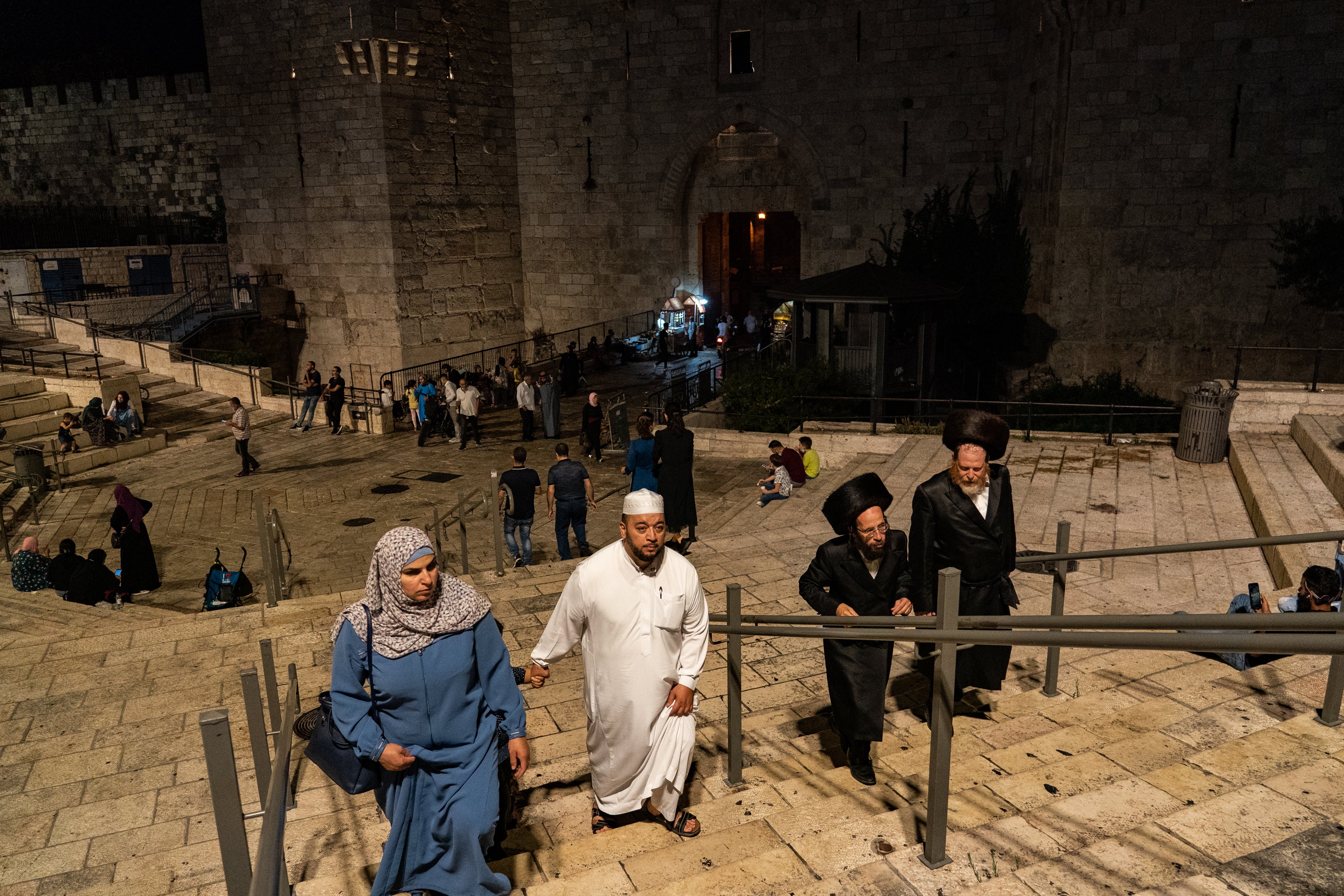
Hazalin has worked for 13 years as a security guard and then maintenance man at Psagot Winery, an elegant stone complex at the far end of the industrial park. Before that, he was a guard at another settlement and previously a construction labourer inside Israel. Palestinian employers could never afford to pay him, he says.
On this particular morning, he’s helping set up for a Jewish wedding later in the day. His Hebrew is good enough to understand instructions from the bride and the mother: place the chairs just beside the Jewish wedding canopy, so the guests have a view of the minarets of Mukhamas, the Palestinian village across the valley.
Psagot bills itself as being “in the heart of Israel.” In 2019, owner Yaakov Berg sued the European Union for the right to stamp “Product of Israel” on his exported wine, made from grapes grown at another, nearby settlement. He lost – EU rules still distinguish between products from Israel and the occupied territories – but Psagot emerged as a favourite of right-wing Zionists. On the day a helicopter brought US secretary of state Mike Pompeo for lunch in 2020, Hazalin was told to stay away for “security reasons.”
With the arrival of evening, shadows stretch deep in the valleys and Hazalin mounts the winery’s blue tractor and trundles onto the highway, towing a trailer full of freshly stripped grape stems and leaves he gets as a perk. After one harrowing stretch through Route 60 traffic, he ascends a dirt ridge and pulls up beside a collection of metal shacks and corrals, the impoverished Bedouin encampment that has been his family home since the 1950s.
Before he even fully stops, young boys swarm the tractor, climb into the trailer and pitch the stems and leaves down to dozens of milling goats.
Looking back across the ridge to his Israeli workplace, Hazalin can no longer imagine two separate states being split from the single economy of occupation. “We are too mixed together now,” he says. “There is not a border you could fit between us.”
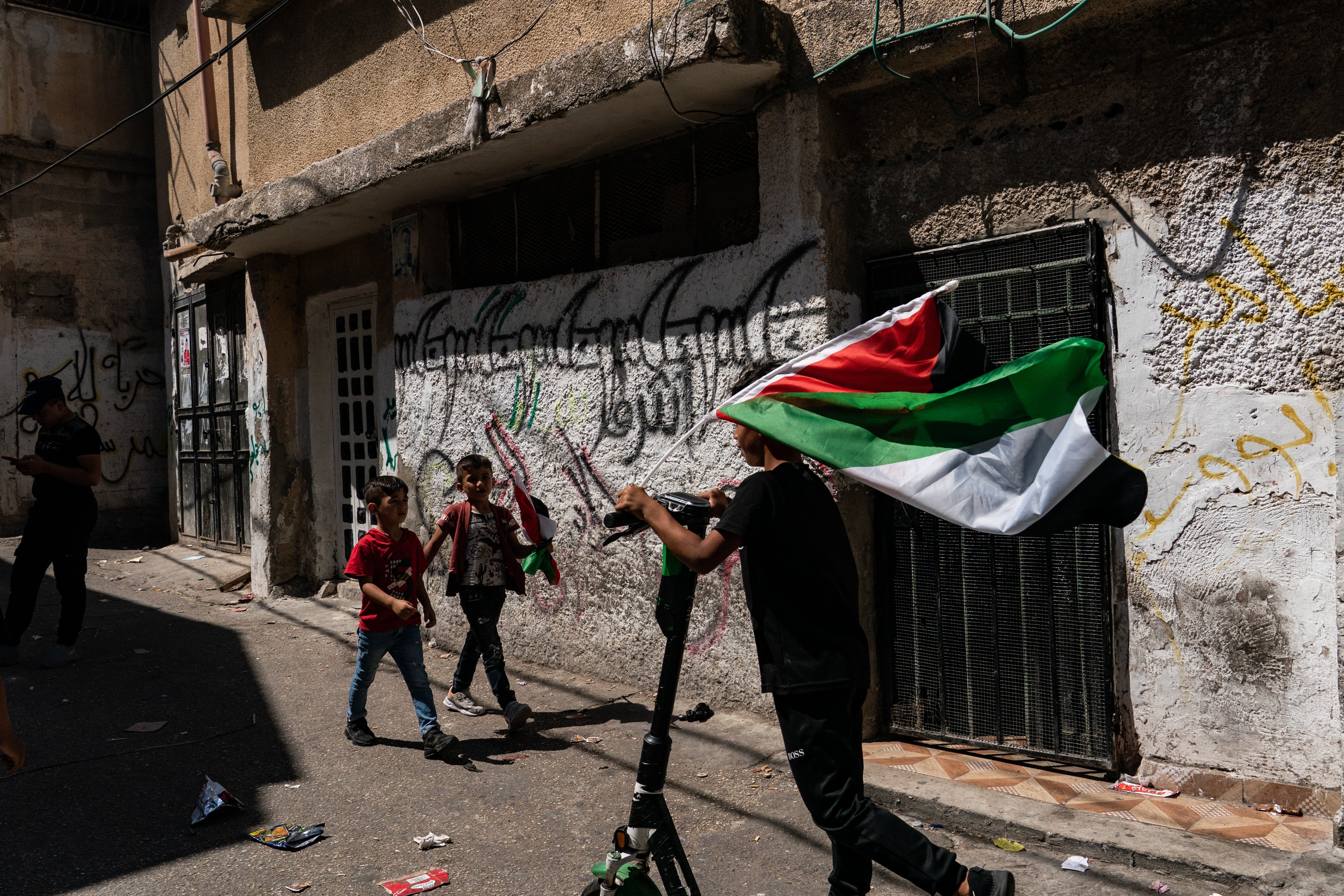
Mile 89: The old city
A shrinking space for compromise on Jerusalem
Simkha Raz is determined to defy the prohibitions of his government and many of his rabbis. As he ascends the long wooden staircase leading up to the sacred plaza revered by Jews as the Temple Mount, the 22-year-old religious school student prepares to pray.
From the opposite side, a 24-year-old Palestinian gas station attendant named Alaa Judeh enters the plaza, which Muslims revere as their Noble Sanctuary, determined to stop him.
This is the latest encounter in the heart of Jerusalem’s Old City between right-wing Israelis and Palestinians committed to defending Muslim control over the site of the al-Aqsa Mosque, Islam’s third-holiest shrine. It is an increasingly tense confrontation that has previously seen screaming matches turn into fistfights among Jewish worshipers, Palestinian protesters and Israel security forces. Clashes on the site triggered the devastating air war this spring between Israel and the Hamas militant group in Gaza.
It is also evidence of how zealotry has come in recent years to dominate the dispute over Jerusalem, which has long been perhaps the most contentious issue dividing Israelis and Palestinians. Both sides claim the eastern portion of Jerusalem, which Israel captured in the 1967 war. And any realistic plan to establish a Palestinian state would have to address Palestinian aspirations to place its capital in Jerusalem, perhaps through creative diplomacy and some form of shared control.
This brewing dismay has become so intense that it is now sapping the enthusiasm that Palestinians have long felt for the prospect of their own state
But with hard-liners increasingly driving the debate, the space for compromise has noticeably shrunk.
Route 60 runs alongside the ancient walls of the Old City. A short walk away is the Temple Mount, where the first and second temples of the Jews once stood. For years, many religious Jews steered clear of the plaza, fearing they might inadvertently step in a spot where only high priests are allowed to tread, and Israel’s chief rabbinate still decrees the site off-limits to Jews. The government of Jordan, which controlled the area before the 1967 war, still administers the plaza and forbids non-Muslim prayer there.
As Raz approaches the outdoor staircase leading to the plaza, an Israeli police officer instructs him: Jews must not pray here – no prayer books or prayer shawls, no swaying as many devout Jews do when they pray.
But Raz is bent on guerrilla worship, ignoring any risk of transgression or violence. His goal is Jewish dominance over the Temple Mount and hastening the arrival of the messiah. “We are preparing for our complete salvation,” he says. He reaches the top of the staircase, joined by more than a dozen fellow believers.
Raz is part of a movement that once dwelled on the fringe of Israeli politics. In years past, when religious zealots visited the Temple Mount, ostensibly to sightsee but surreptitiously moving their lips in silent prayer or pretending to speak on a cellphone, Israeli police would intervene. But in the past two years, Israel’s powerful right wing has pressured security forces to turn a blind eye.
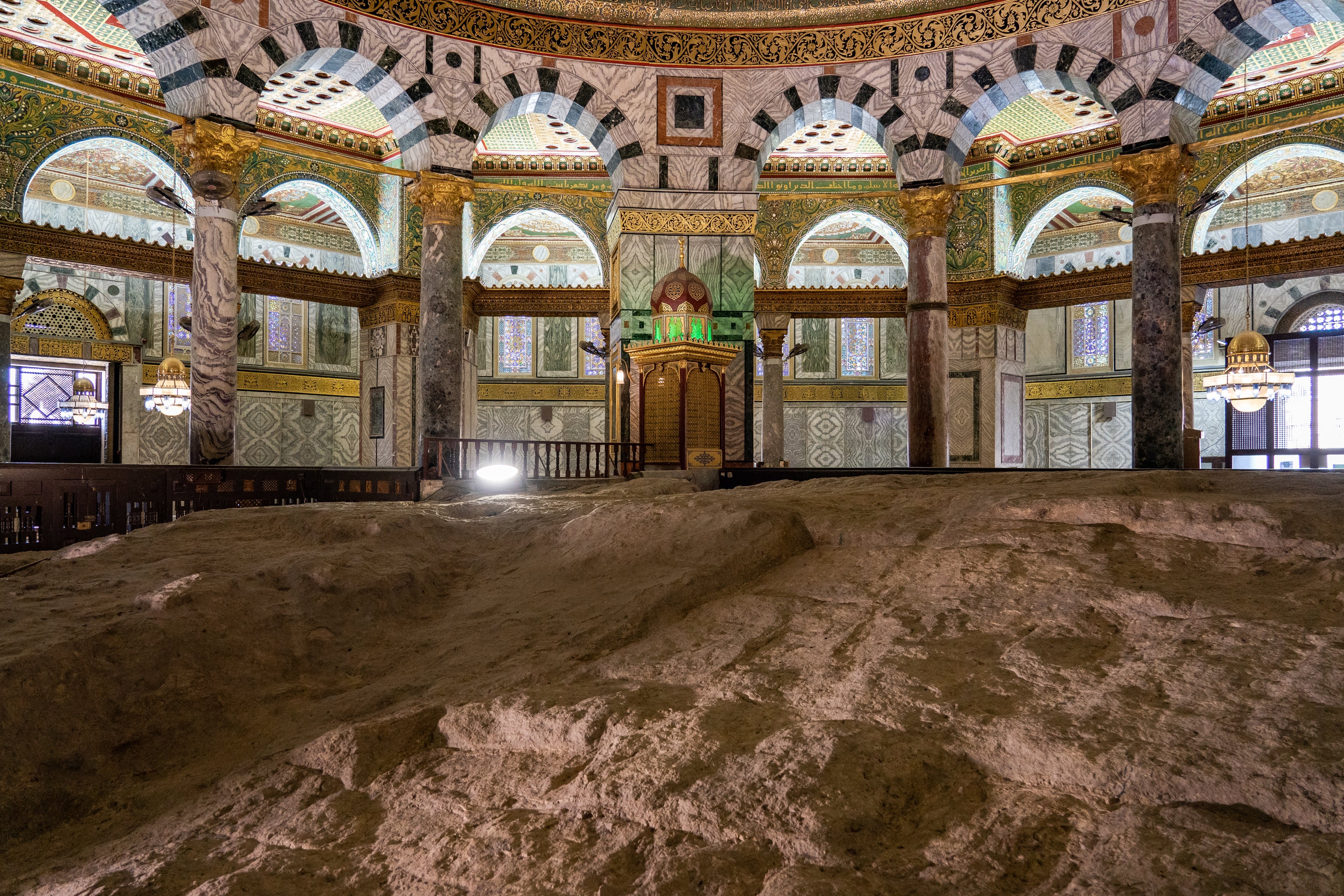
On this day, social media had been buzzing with news that a group of Israelis would defy the prayer ban.
For Judeh, the plaza is not only a sacred place but a unique haven. On the streets of his predominantly Arab neighbourhood, Israeli security forces routinely ask for his ID. But here, no one bothers him as he walks toward the iconic Dome of the Rock. “It is the only place in Jerusalem we are free,” he says.
Inside, he places a reverent hand on the boulder where it is said the prophet Muhammad ascended to heaven. Judeh inhales the musty incense aroma. Now he is ready, if necessary, to confront the Israelis wandering around the plaza.
Raz and his group pause in the shade of an olive tree. He begins reciting prayers, clearly if not loudly. An Israeli security officer looks at him, then looks away. After a few minutes, officers ask the group to keep moving.
Judeh stands at a distance, outside al-Aqsa Mosque, alert for provocations. He cannot tell if Raz’s group is praying. If they are, it is quietly.
Judeh relaxes.
But he knows that they will be back. And so will he.
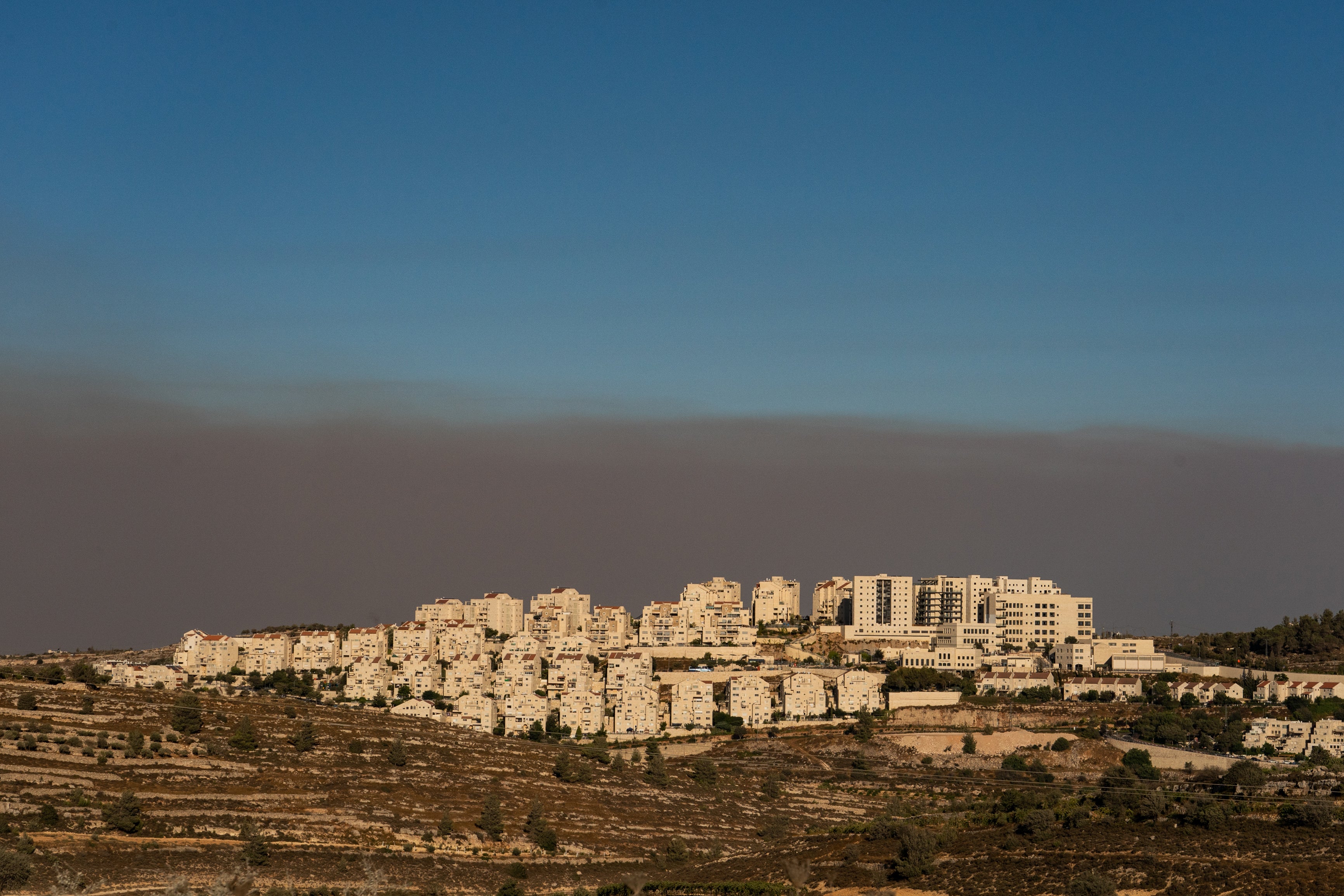
Mile 115: Hebron
A growing distrust of leadership
On the night that Nizar Banat was beaten to death, it was so still you could hear trucks passing in the distance on Route 60.
“This is his bed,” says his brother Gassan Banat, standing before three pallets placed close together, just as they were at 3am on that June night when a crowbar smashed into the metal window shutters of the home in Hebron, in the southern West Bank, about a 45-minute drive from Jerusalem.
Nizar Banat, 42 – a well-known critic of the Palestinian Authority, which administers part of the West Bank – had been staying in this house for weeks, ever since his home had been attacked with bullets and stun grenades. He had blamed Palestinian security forces for that attack, likening them to “a gang led by gangsters.”
His death has been widely blamed on the Palestinian Authority, which was established after the Oslo accords with Israel more than 25 years ago, and further inflamed the anger many Palestinians feel toward their leaders.
This brewing dismay has become so intense that it is now sapping the enthusiasm that Palestinians have long felt for the prospect of their own state. In the West Bank, many people no longer believe their deeply flawed leaders can deliver independence and fear that if they did, Palestine would resemble the corrupt and brutal autocracies so common in the Middle East.
Immediately, more than a dozen more men came through the door and crowded around the beds, beating Nizar with bars, pistols and a bat
While Nizar had been sheltering in the Hebron house, he was working on a new video. This one would have highlighted examples of corruption that are much discussed over hookah pipes in Palestinian cafes but not often aired on social media.
His earlier videos, addressing mismanagement and factionalism in addition to corruption, had proved popular. Recent broadsides had slammed the Palestinian Authority’s failures at containing the coronavirus pandemic and President Mahmoud Abbas’s decision this spring to cancel the first scheduled elections in more than a decade. Nizar, who had planned to run, had called for the European Union to cut off aid to the authority.
“Nizar understood the public mood,” his brother Gassan says. “That is why they did what they did to him.”
Nizar’s younger cousins, Mohammed and Hussein Banat, had been lying next to him, chatting with him late into the night. They often stayed with Nizar to keep him company – and safe.
“We hadn’t been asleep long,” Mohammed recalls.
Recounting that night, Mohammed points out the bent shutters and describes the crash that snapped him awake. A man with an iron crowbar climbed through the opening. Then a second assailant entered the room, holding a pistol that he pointed toward the cousins.
Hussein watched the man with the crowbar lean over Nizar’s bed and lift the blanket. “He checked his face to make sure it was him,” Hussein says. Then the man reared back and slammed the crowbar into the left side of Nizar's forehead “with his full strength.”
Immediately, more than a dozen more men came through the door and crowded around the beds, beating Nizar with bars, pistols and a bat, Hussein said.
“It would have been so easy to arrest him but that is not what they came for,” Mohammed says.
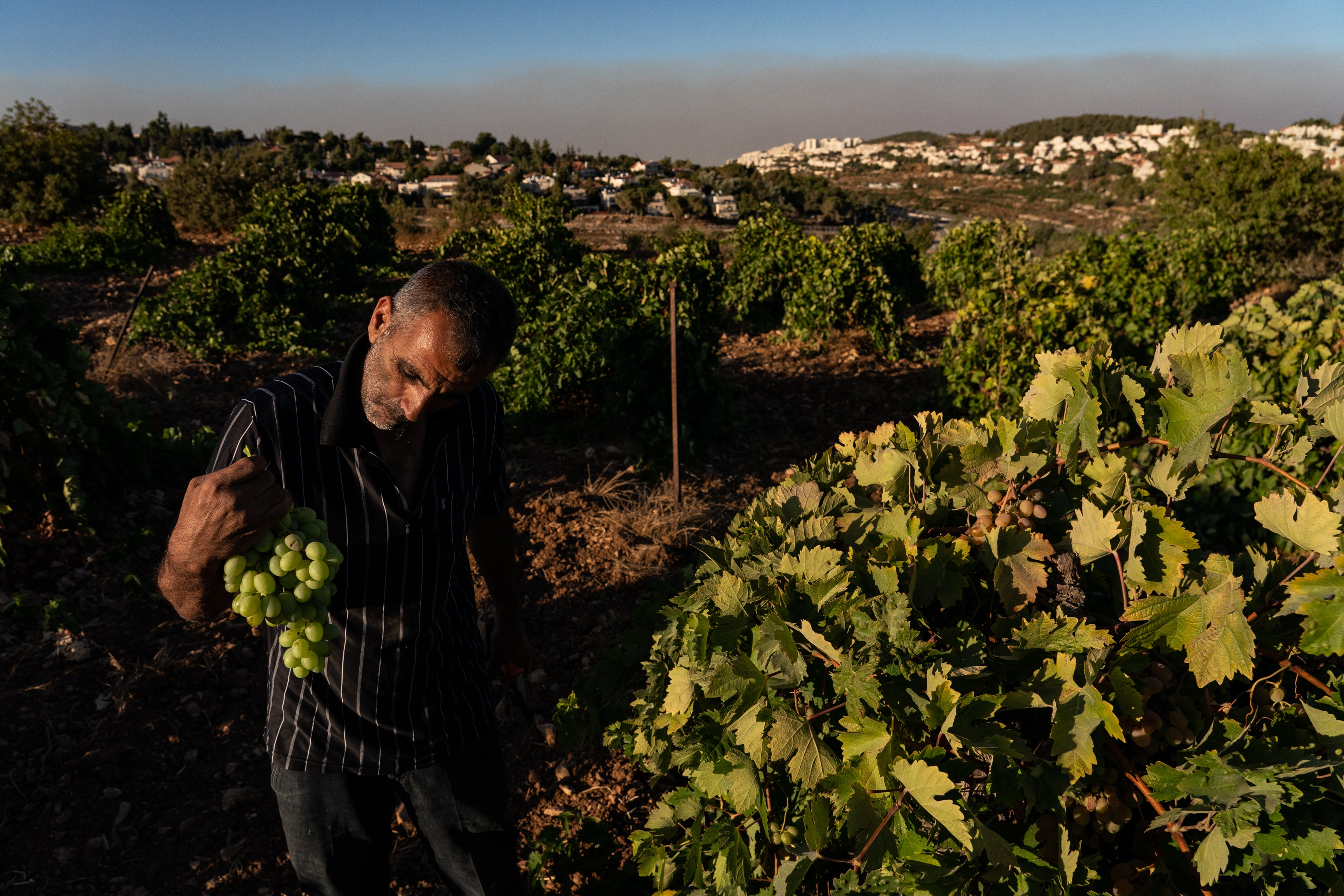
They stripped Nizar of his shirt and flipped him onto his stomach, cuffing his arms behind. Three more men entered, each wearing the vest of the Palestinian Preventive Security Force (PSF), an intelligence unit.
The men pulled Nizar to his feet, propped his back against a concrete column and began slamming his head into it. “Ten or 12 times they did it,” Hussein recalls, his eyes distant.
A statement issued by the Palestinian Authority said Nizar’s health had “deteriorated” during his arrest and that “it was found that he had passed away.” Fourteen PSF agents were later charged with abuse of power and violating military instructions.
Outside the house, someone has stencilled Nizar’s face on a wall. A poster with his picture is on a nearby light pole, the same poster seen at the protests in Ramallah and Hebron that erupted after his death. They have repeatedly turned bloody with Palestinian forces cracking down violently.
“They have opened a huge gap between themselves and the people,” says Gassan, locking the door to the house.“ Now the people see it as Nizar did – a gang led by gangsters.”
Mile 146: Beersheba
A conflict that’s near, yet far from mind
South of Hebron, the Negev Desert spreads wide and dry as Route 60 winds to another military checkpoint.
Palestinian day labourers amass at this southern exit from the West Bank, waiting for rides into Israel. Israeli soldiers wave through most cars with Israeli plates, stop those with Palestinian ones.
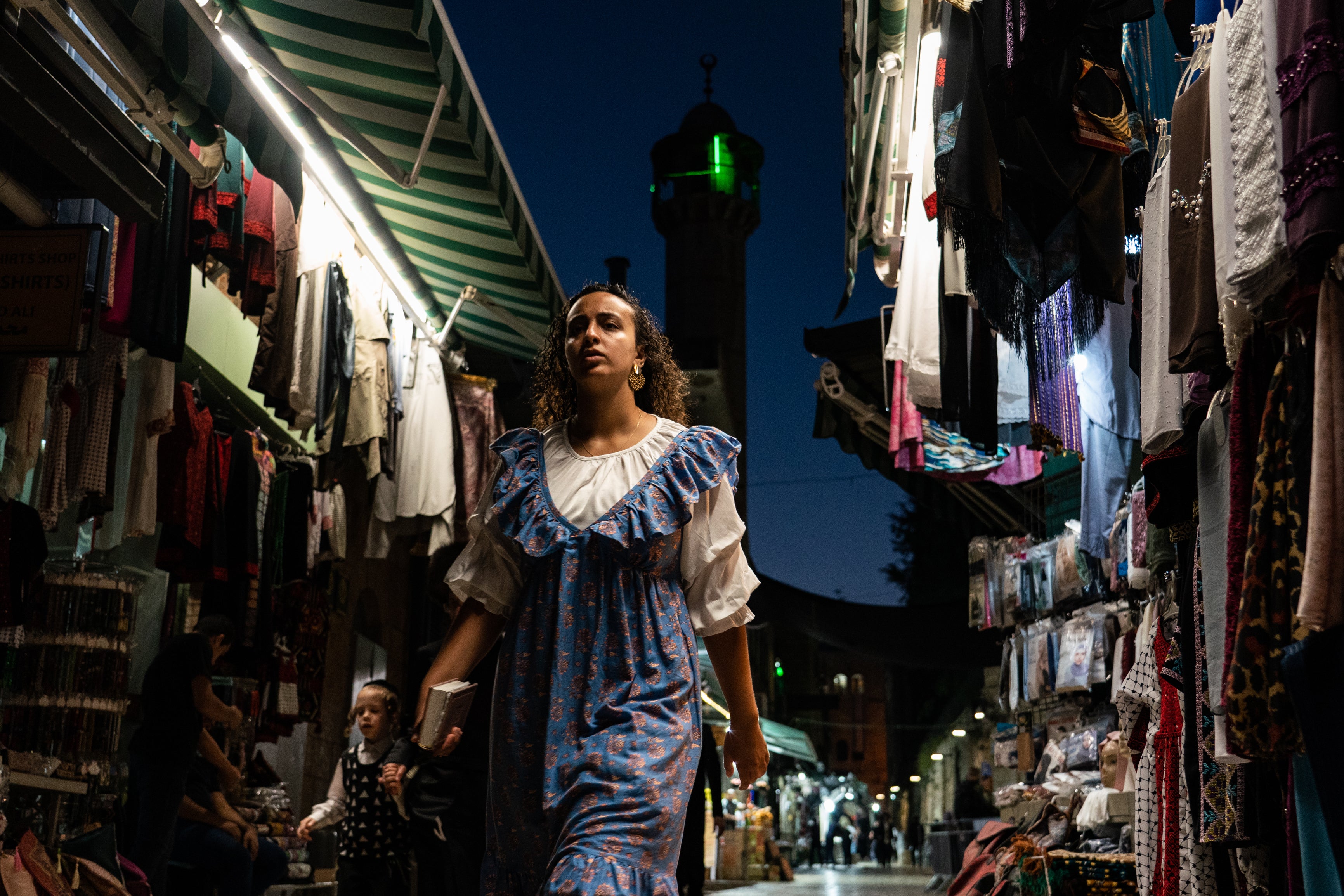
Twelve miles on, in the Israeli city of Beersheba, Route 60 comes to end, terminating at an entrance to the Mall of the Negev, the city’s largest shopping centre. Here, amid 1.2 million sq ft of air-conditioned commerce, the question on the lips of many Israelis when asked about the conflict with the Palestinians is: what conflict?
Lidor Zahari, 25, seems almost surprised to be asked about the generations-long standoff with the Palestinians. His interaction with them largely amounts to selling them cellphone chargers, cases and screen protectors when they stop by the kiosk where he works.
“It feels that it’s not really connected to me,” he says amid the chattering echoes of strolling families. “The conflict is next door, yes, but it still feels that I don't have contact with it. We’ve already gotten used to it.”
Zahari, who is training to be a barber, says he is taken aback when the issue is raised by outsiders, like foreign singers who balk at performing in Israel or the European soccer players who recently hesitated to play in Beersheba because the Gaza Strip is 25 miles away.
“What they don’t understand is that they shouldn’t be afraid,” he says. “It’s just regular life.”
So if there’s no pressing dispute to be settled, what need is there for a solution – much less a two-state solution that would require substantial sacrifices by Israel?
The “Palestinian issue” used to dominate Israeli political discourse, but it has all but disappeared as a topic during the four national elections Israel conducted in the past three years. In one survey of voter concerns by the B’Tselem human rights group, the conflict with the Palestinians ranked sixth, well behind the economy, cost of living and other domestic issues.
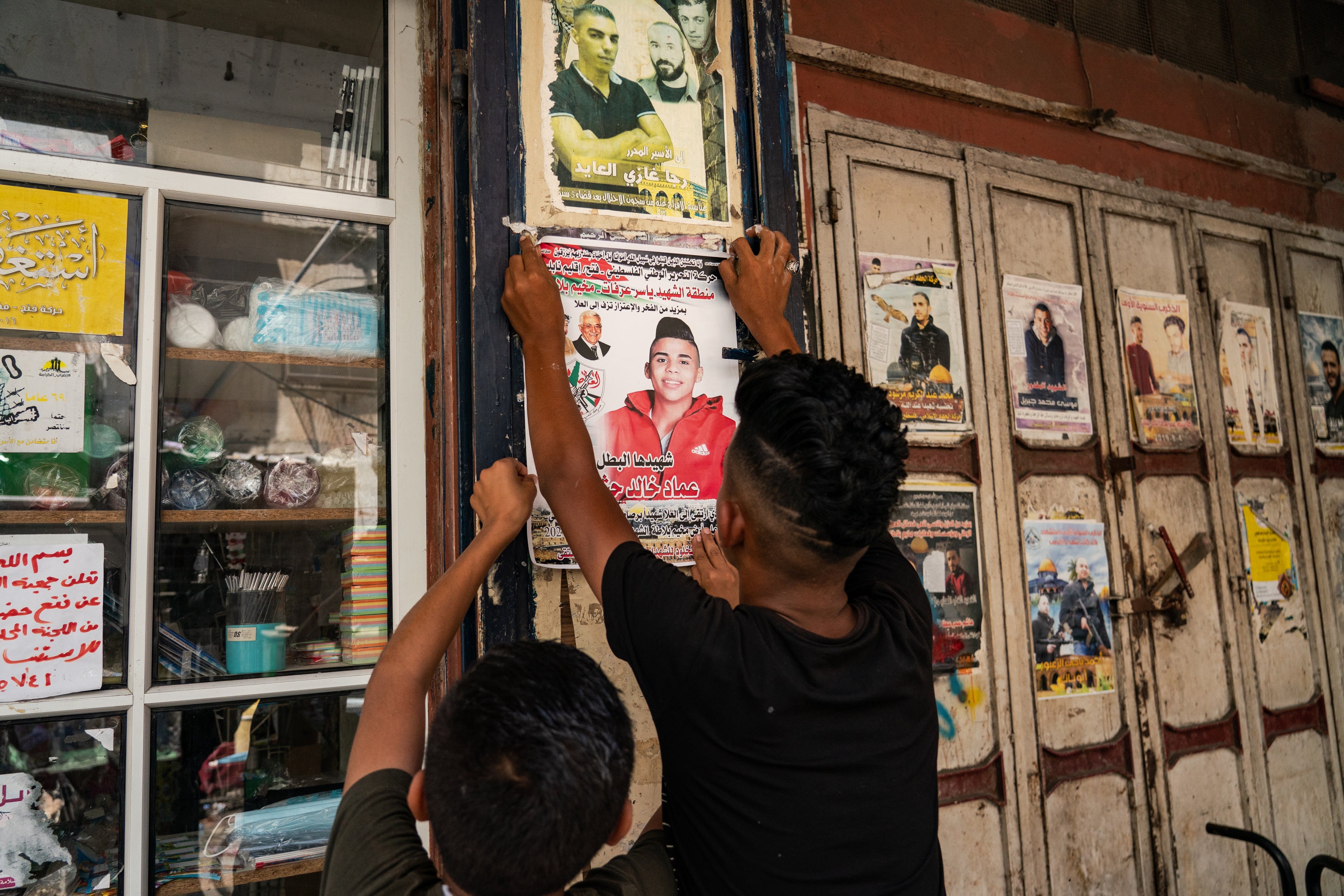
The era of terrorist bus bombings that rattled Israelis for years is a decade in the past. Former prime minister Benjamin Netanyahu, during 15 years in power, deliberately sidelined the issue, persuading Israelis that life could go on without any solution to the conflict – and certainly without allowing Palestinians their own state. The accords that Israel signed last year to normalise relations with the United Arab Emirates, Bahrain, Morocco and Sudan showed Israelis they could make diplomatic inroads with their neighbours even if the Palestinian issue was unresolved.
After decades of stalemate, the status quo has been woven into the fabric of daily life. Even the periodic flare-ups of violence do little to raise any sense of urgency.
Daniel Mamo, sipping cappuccino and listening to music on headphones outside Aroma Cafe, recalls the May air war with Hamas, when rockets fired from Gaza flew over faster than he could keep track. But when the sirens sounded, he didn’t budge.
“I, many times, was sitting in a cafe and didn’t move,” he says with a shrug. “And there were others all around me.”
Mamo, a 45-year-old immigrant from Ethiopia, thinks he has an outsider’s perspective, a bit different than that of most Israelis. And what he sees is that “we have all gotten used to despair.”
“At this point, the country does not allow itself to even aspire to anything different,” he says.
And, with a smile, he puts his headphones back on.
Additional reporting by Shira Rubin, Salwan Georges and Sufian Taha
© Washington Post
Join our commenting forum
Join thought-provoking conversations, follow other Independent readers and see their replies
Comments